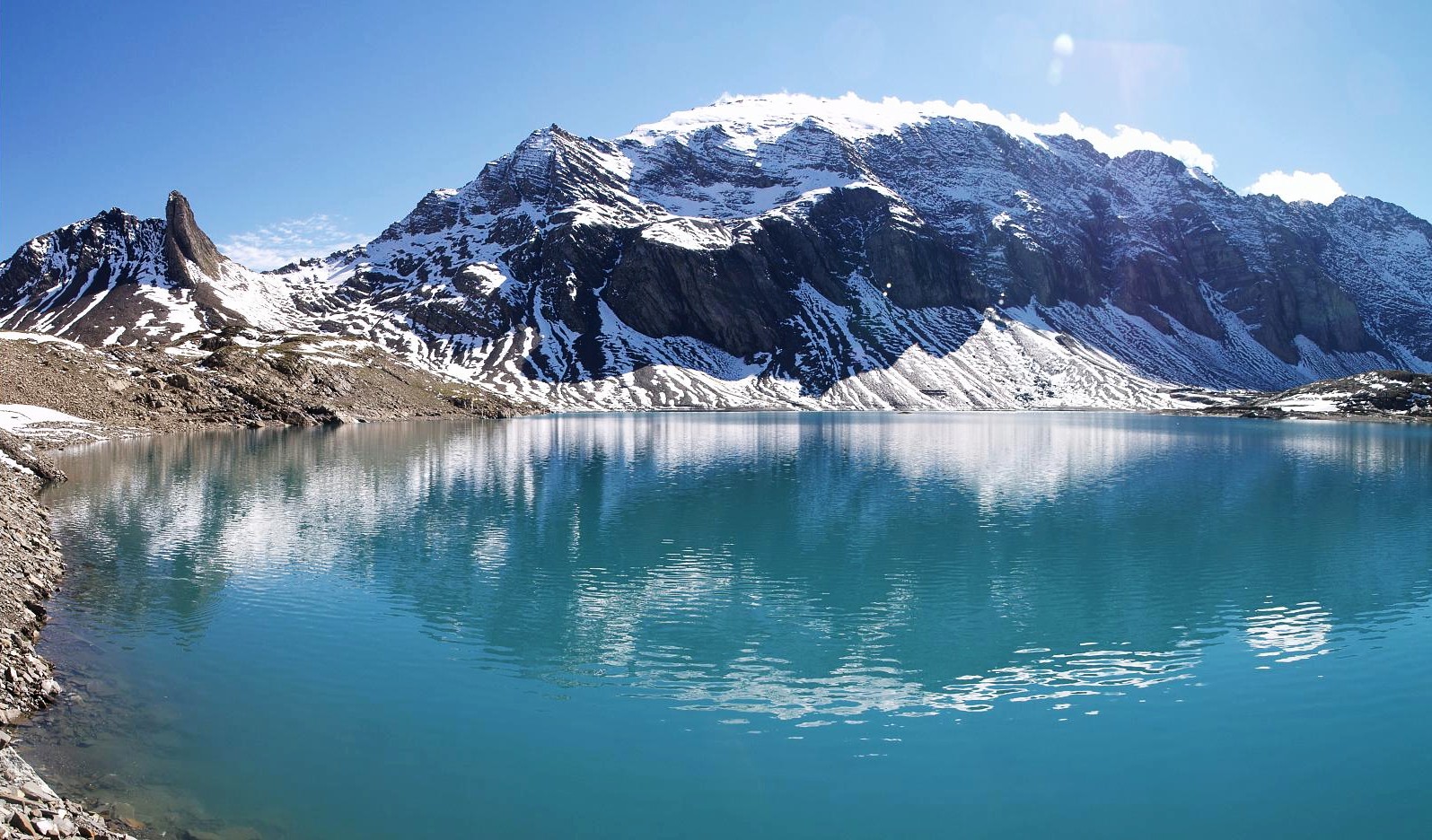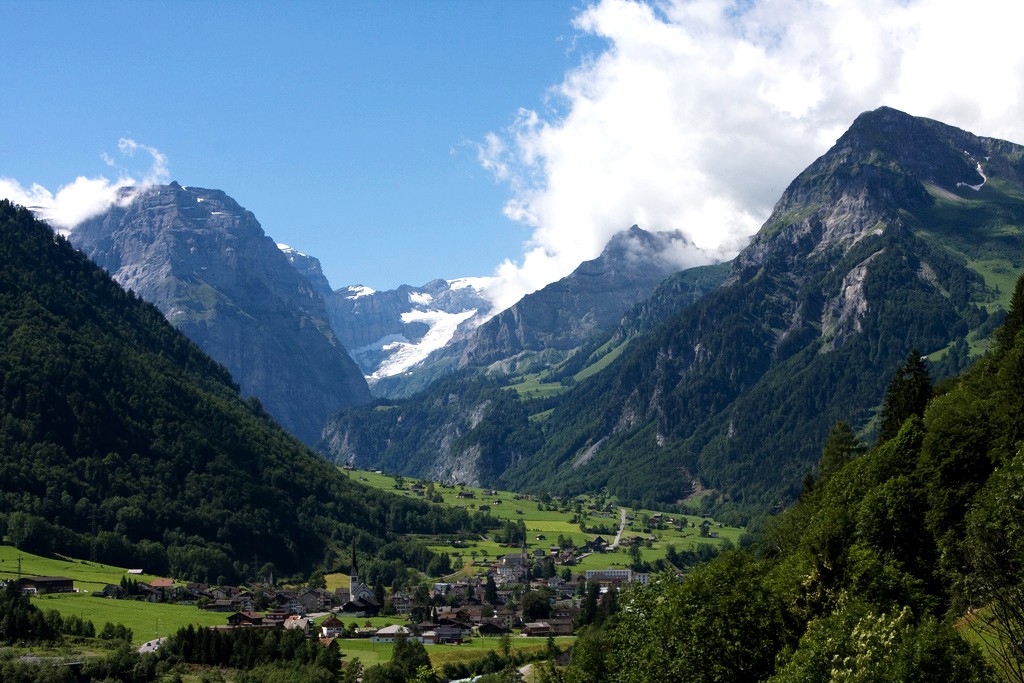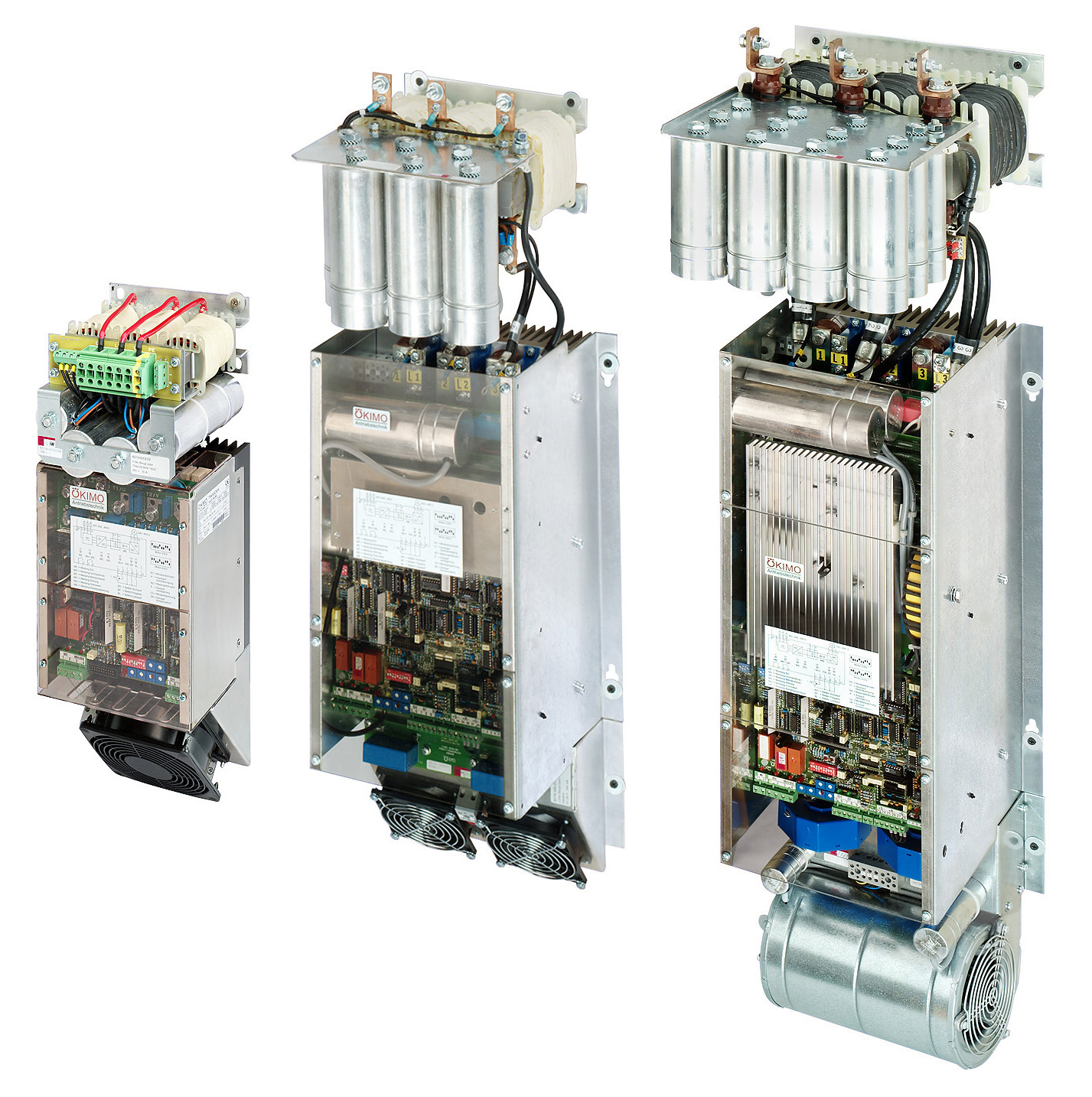|
Linth–Limmern Power Stations
The Linth–Limmern Power Stations are a system of hydroelectric power stations located south of Linthal in the canton of Glarus, Switzerland. The system uses five reservoirs and four power stations at steep variations in altitude. Works on the complex began in 1957 with the construction of Lake Limmern Dam and the Mutt, Tierfehd and Linthal Power Stations. The dam was complete in 1963 and the power stations were all operational by 1968, with an installed capacity of 340 MW. In 2009, a 140 MW pumped-storage component between Lake Limmern and Tierfehd Reservoir was commissioned. In 2010, construction began on the Linthal 2015 Project, which included the expansion of Lake Mutt and Tierfehd Reservoir, and the addition of the Limmern Power Station, a 1,000 MW pumped-storage component between Lake Mutt and Lake Limmern. Commissioning of the last unit in Limmern was completed by December 2017, bringing the total installed capacity of the system to 1480 MW. Design and operation The hig ... [...More Info...] [...Related Items...] OR: [Wikipedia] [Google] [Baidu] |
Linthal, Glarus
Linthal is a village, and former municipality, in the municipality of Glarus Süd and canton of Glarus in Switzerland. The village lies near the head of the valley of the Linth river, and at the foot of the Klausen Pass into the canton of Uri. It is the terminus of the railway line that traverses the length of Glarus. History Linthal is first mentioned in 1289 as ''Lintal''. In 1879, Linthal was connected to the Swiss railway network by the opening of the Swiss Northeastern Railway line from Weesen. The road over the Klausen Pass was built between 1895 and 1900. Construction of the Linth–Limmern hydro-electric power scheme, in the mountains above Linthal, commenced in 1957, and was fully operational by 1968. In 2011, the municipality of Linthal was merged into the new municipality of Glarus Süd. Geography The village Linthal lies at the head of the valley of the Linth river, at an altitude of approximately . It is surrounded by mountains, including Ortstock (), C ... [...More Info...] [...Related Items...] OR: [Wikipedia] [Google] [Baidu] |
Adjustable-speed Drive
Motor drive means a system that includes a motor. An adjustable speed motor drive means a system that includes a motor that has multiple operating speeds. A variable speed motor drive is a system that includes a motor and is continuously variable in speed. If the motor is generating electrical energy rather than using it – this could be called a generator drive but is often still referred to as a motor drive. A Variable Frequency Drive(VFD) or Variable Speed Drive(VSD) describes the electronic portion of the system that controls the speed of the motor. More generally, the term drive, describes equipment used to control the speed of machinery. Many industrial processes such as assembly lines must operate at different speeds for different products. Where process conditions demand adjustment of flow from a pump or fan, varying the speed of the drive may save energy compared with other techniques for flow control. Where speeds may be selected from several different pre-set ran ... [...More Info...] [...Related Items...] OR: [Wikipedia] [Google] [Baidu] |
Arch Dams
An arch is a vertical curved structure that spans an elevated space and may or may not support the weight above it, or in case of a horizontal arch like an arch dam, the hydrostatic pressure against it. Arches may be synonymous with vaults, but a vault may be distinguished as a continuous arch forming a roof. Arches appeared as early as the 2nd millennium BC in Mesopotamian brick architecture, and their systematic use started with the ancient Romans, who were the first to apply the technique to a wide range of structures. Basic concepts An arch is a pure compression form. It can span a large area by resolving forces into compressive stresses, and thereby eliminating tensile stresses. This is sometimes denominated "arch action". As the forces in the arch are transferred to its base, the arch pushes outward at its base, denominated "thrust". As the rise, i. e. height, of the arch decreases the outward thrust increases. In order to preserve arch action and prevent collapse ... [...More Info...] [...Related Items...] OR: [Wikipedia] [Google] [Baidu] |
Dams In Switzerland
A dam is a barrier that stops or restricts the flow of surface water or underground streams. Reservoirs created by dams not only suppress floods but also provide water for activities such as irrigation, human consumption, industrial use, aquaculture, and navigability. Hydropower is often used in conjunction with dams to generate electricity. A dam can also be used to collect or store water which can be evenly distributed between locations. Dams generally serve the primary purpose of retaining water, while other structures such as floodgates or levees (also known as dikes) are used to manage or prevent water flow into specific land regions. The earliest known dam is the Jawa Dam in Jordan, dating to 3,000 BC. The word ''dam'' can be traced back to Middle English, and before that, from Middle Dutch, as seen in the names of many old cities, such as Amsterdam and Rotterdam. History Ancient dams Early dam building took place in Mesopotamia and the Middle East. Dams were used ... [...More Info...] [...Related Items...] OR: [Wikipedia] [Google] [Baidu] |
Energy Infrastructure Completed In 1968
In physics, energy (from Ancient Greek: ἐνέργεια, ''enérgeia'', “activity”) is the quantitative property that is transferred to a body or to a physical system, recognizable in the performance of work and in the form of heat and light. Energy is a conserved quantity—the law of conservation of energy states that energy can be converted in form, but not created or destroyed. The unit of measurement for energy in the International System of Units (SI) is the joule (J). Common forms of energy include the kinetic energy of a moving object, the potential energy stored by an object (for instance due to its position in a field), the elastic energy stored in a solid object, chemical energy associated with chemical reactions, the radiant energy carried by electromagnetic radiation, and the internal energy contained within a thermodynamic system. All living organisms constantly take in and release energy. Due to mass–energy equivalence, any object that has mass whe ... [...More Info...] [...Related Items...] OR: [Wikipedia] [Google] [Baidu] |
Dams Completed In 1963
A dam is a barrier that stops or restricts the flow of surface water or underground streams. Reservoirs created by dams not only suppress floods but also provide water for activities such as irrigation, human consumption, industrial use, aquaculture, and navigability. Hydropower is often used in conjunction with dams to generate electricity. A dam can also be used to collect or store water which can be evenly distributed between locations. Dams generally serve the primary purpose of retaining water, while other structures such as floodgates or levees (also known as dikes) are used to manage or prevent water flow into specific land regions. The earliest known dam is the Jawa Dam in Jordan, dating to 3,000 BC. The word ''dam'' can be traced back to Middle English, and before that, from Middle Dutch, as seen in the names of many old cities, such as Amsterdam and Rotterdam. History Ancient dams Early dam building took place in Mesopotamia and the Middle East. Dams were us ... [...More Info...] [...Related Items...] OR: [Wikipedia] [Google] [Baidu] |
List Of Power Stations In Switzerland
The following page lists power stations in Switzerland. For traction current see List of installations for 15 kV AC railway electrification in Germany, Austria and Switzerland. Hydroelectric There are 556 hydroelectric power plants in Switzerland that have a capacity of at least 300 kW. Some of these are listed below: Nuclear Thermal A gas turbine testing facility in Birr AG, belonging to Ansaldo Energia, sometimes feeds up to 740 megawatts into the Swiss electricity grid. See also * List of power stations in Europe * List of largest power stations in the world * List of wind farms in Switzerland In Switzerland, there are 11 wind farms in operation. Only wind farms or turbines with a rated capacity of over 1 megawatt are included in this list. __TOC__ Source: Wind farms in planning or under construction See also * List of power stati ... References {{DEFAULTSORT:Power Stations In Switzerland Switzerland Lists of buildings and structures in Switze ... [...More Info...] [...Related Items...] OR: [Wikipedia] [Google] [Baidu] |
List Of Tallest Dams In Switzerland ...
List of dams in Switzerland which are taller than 100 meters: See also * List of lakes with a dam in Switzerland * List of tallest dams in the world External links {{commons category, Dams in Switzerland *http://www.swissdams.ch Switzerland Switzerland Dams Dams A dam is a barrier that stops or restricts the flow of surface water or underground streams. Reservoirs created by dams not only suppress floods but also provide water for activities such as irrigation, human consumption, industrial use ... [...More Info...] [...Related Items...] OR: [Wikipedia] [Google] [Baidu] |
List Of Pumped-storage Hydroelectric Power Stations
The following page lists all pumped-storage hydroelectric power stations that are larger than in installed generating capacity, which are currently operational or under construction. Those power stations that are smaller than , and those that are decommissioned or only at a planning/proposal stage may be found in regional lists, listed at the end of the page. List of plants larger than 1000 MW capacity The table below lists currently operational power stations. Some of these may have additional units under construction, but only current installed capacity is listed. Under construction This table lists future 1,000 MW or larger stations that are under construction; some may be partially operational with a current installed capacity under 1,000 MW. See also * List of energy storage projects * List of hydroelectric power station failures * Lists of hydroelectric power stations * List of largest power stations * United States Department of Energy Global En ... [...More Info...] [...Related Items...] OR: [Wikipedia] [Google] [Baidu] |
Pump
A pump is a device that moves fluids (liquids or gases), or sometimes slurries, by mechanical action, typically converted from electrical energy into hydraulic energy. Pumps can be classified into three major groups according to the method they use to move the fluid: ''direct lift'', ''displacement'', and ''gravity'' pumps. Mechanical pumps serve in a wide range of applications such as pumping water from wells, aquarium filtering, pond filtering and aeration, in the car industry for water-cooling and fuel injection, in the energy industry for pumping oil and natural gas or for operating cooling towers and other components of heating, ventilation and air conditioning systems. In the medical industry, pumps are used for biochemical processes in developing and manufacturing medicine, and as artificial replacements for body parts, in particular the artificial heart and penile prosthesis. When a casing contains only one revolving impeller, it is called a single-stage pump. ... [...More Info...] [...Related Items...] OR: [Wikipedia] [Google] [Baidu] |
Hydraulic Head
Hydraulic head or piezometric head is a specific measurement of liquid pressure above a vertical datum., 410 pages. See pp. 43–44., 650 pages. See p. 22. It is usually measured as a liquid surface elevation, expressed in units of length, at the entrance (or bottom) of a piezometer. In an aquifer, it can be calculated from the depth to water in a piezometric well (a specialized water well), and given information of the piezometer's elevation and screen depth. Hydraulic head can similarly be measured in a column of water using a standpipe piezometer by measuring the height of the water surface in the tube relative to a common datum. The hydraulic head can be used to determine a ''hydraulic gradient'' between two or more points. "Head" in fluid dynamics In fluid dynamics, ''head'' is a concept that relates the energy in an incompressible fluid to the height of an equivalent static column of that fluid. From Bernoulli's principle, the total energy at a given point in a f ... [...More Info...] [...Related Items...] OR: [Wikipedia] [Google] [Baidu] |
Francis Pump-turbine
The Francis turbine is a type of water turbine. It is an inward-flow reaction turbine that combines Radial turbine, radial and Axial flow turbine, axial flow concepts. Francis turbines are the most common water turbine in use today, and can achieve over 95% efficiency. The process of arriving at the modern Francis runner design took from 1848 to approximately 1920. It became known as the Francis turbine around 1920, being named after British-American engineer James B. Francis who in 1848 created a new turbine design. Francis turbines are primarily used for producing electricity. The power output of the electric generators generally ranges from just a few kilowatts up to 1000 MW, though mini-hydro installations may be lower. The best performance is seen when the Hydraulic head, head height is between . Penstock diameters are between . The speeds of different turbine units range from 70 to 1000 rpm. A Wicket gate (hydraulics), wicket gate around the outside of the Water turb ... [...More Info...] [...Related Items...] OR: [Wikipedia] [Google] [Baidu] |





.jpg)

